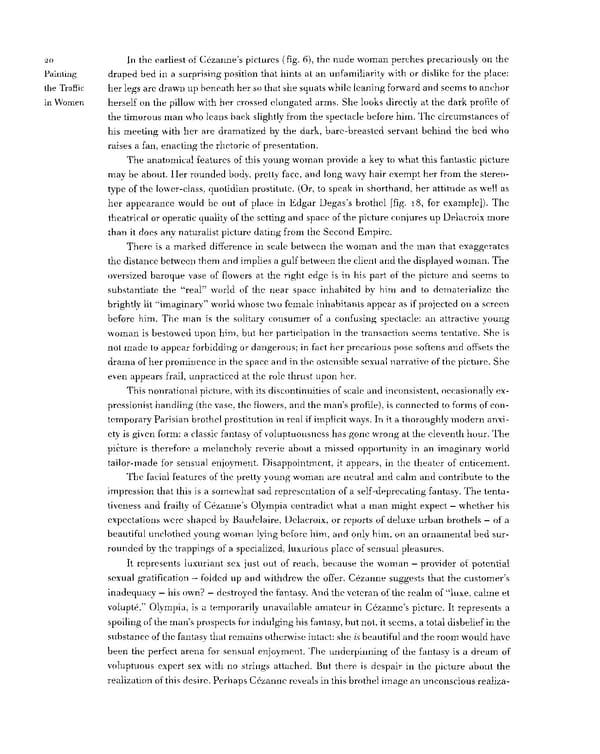20 In the earliest of Cezanne's pictures (fig. 6), the nude woman perches precariously on the Painting draped bed in a surprising position that hints at an unfarniliarity with or dislike for the place: the Traffic her legs are drawn up beneath her so that she squats while leaning forward and seems to anchor in Women herself on the pillow with her crossed elongated arms. She looks directly at the dark profile of the timorous man who leans back slightly from the spectacle before him. The circumstances of his meeting with her are dramatized by the dark, bare-breasted servant behind the bed who raises a fan, enacting the rhetoric of presentation. The anatomical features of this young woman provide a key to what this fantastic picture may be about. Her rounded body, pretty face, and long wavy hair exempt her from the stereo- type of the lower-class, quotidian prostitute. (Or, to speak in shorthand, her attitude as well as her appearance would be out of place in Edgar Degas's brothel [fig. 18, for example]). The theatrical or operatic quality of the setting and space of the picture conjures up Delacroix more than it does any naturalist picture dating from the Second Empire. There is a marked difference in scale between the woman and the man that exaggerates the distance between them and implies a gulf between the client and the displayed woman. The oversized baroque vase of flowers at the right edge is in his part of the picture and seems to substantiate the "real" world of the near space inhabited by him and to dematerialize the brightly lit "imaginary" world whose two female inhabitants appear as if projected on a screen before him. The man is the solitary consumer of a confusing spectacle: an attractive young woman is bestowed upon him, but her participation in the transaction seems tentative. She is not made to appear forbidding or dangerous; in fact her precarious pose softens and offsets the drama of her prominence in the space and in the ostensible sexual narrative of the picture. She even appears frail, unpracticed at the role thrust upon her. This nonrational picture, with its discontinuities of scale and inconsistent, occasionally ex- pressionist handling (the vase, the flowers, and the man's profile), is connected to forms of con- temporary Parisian brothel prostitution in real if implicit ways. In it a thoroughly modern anxi- ety is given form: a classic fantasy of voluptuousness has gone wrong at the eleventh hour. The picture is therefore a melancholy reverie about a missed opportunity in an imaginary world tailor-made for sensual enjoyment. Disappointment, it appears, in the theater of enticement. The facial features of the pretty young woman are neutral and calm and contribute to the impression that this is a somewhat sad representation of a self-deprecating fantasy. The tenta- tiveness and frailty of Cezanne's Olympia contradict what a man might expect — whether his expectations were shaped by Baudelaire, Delacroix, or reports of deluxe urban brothels — of a beautiful unclothed young woman lying before him, and only him, on an ornamental bed sur- rounded by the trappings of a specialized, luxurious place of sensual pleasures. It represents luxuriant sex just out of reach, because the woman — provider of potential sexual gratification - folded up and withdrew the offer. Cezanne suggests that the customer's inadequacy — his own? — destroyed the fantasy. And the veteran of the realm of "luxe, calme et volupte," Olympia, is a temporarily unavailable amateur in Cezanne's picture. It represents a spoiling of the man's prospects for indulging his fantasy, but not, it seems, a total disbelief in the substance of the fantasy that remains otherwise intact: she is beautiful and the room would have been the perfect arena for sensual enjoyment. The underpinning of the fantasy is a dream of voluptuous expert sex with no strings attached. But there is despair in the picture about the realization of this desire. Perhaps Cezanne reveals in this brothel image an unconscious realiza-
 Prostitution & Impressionists Page 40 Page 42
Prostitution & Impressionists Page 40 Page 42